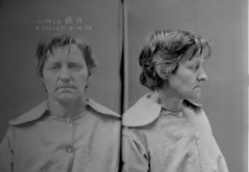
1875 - 1938
Eugene Falleni
Summary
Name:
Years Active:
1917Birth:
July 25, 1875Status:
DeceasedClass:
MurdererVictims:
1Method:
BludgeoningDeath:
June 10, 1938Nationality:
Australia
1875 - 1938
Eugene Falleni
Summary: Murderer
Name:
Eugene FalleniStatus:
DeceasedVictims:
1Method:
BludgeoningNationality:
AustraliaBirth:
July 25, 1875Death:
June 10, 1938Years Active:
1917bio
Eugene Falleni was born on July 25, 1875, in Italy, near either Livorno or Florence. Assigned female at birth, he was the oldest of 22 children, though only seventeen survived childhood. Around 1877, when Falleni was about two years old, his family moved to Wellington, New Zealand. His father was strict and worked various jobs, including a carrier with a horse and cart and as a fisherman.
As Falleni grew up, he often dressed in male clothing to find work in brickyards and stables. In September 1894, he married but soon discovered that his husband was already married to someone else. In 1895, he left New Zealand and began a new life aboard a ship, possibly as a cabin boy. His family did not search for him, having been opposed to his lifestyle.
After spending less than two years at sea, Falleni once revealed to the ship's captain, while drunk, that he was raised as female. He spoke about how his grandmother referred to him as a "piccolina," the feminine form of the word for "little one" in Italian. During his time on the ship, he faced mistreatment from the captain and was left pregnant and without resources in 1898 in Newcastle, New South Wales.

In Sydney, Falleni gave birth to a daughter named Josephine Crawford Falleni. He placed his daughter in the care of an Italian woman named Mrs. de Angelis and began living as Harry Leo Crawford, claiming to be of Scottish descent. He did not visit Josephine often, and she believed her father was a sea captain.
In 1912, after working various jobs, Falleni started working for Dr. G. R. C. Clarke in Northern Sydney. He met Annie Birkett, Clarke's housekeeper, who had a son. Falleni married Birkett in February 1913, and they later moved to Drummoyne, where he worked in hotels and factories. He continued to live as a man and did not disclose his past to Birkett until years later.
murder story
On October 1, 1917, Annie Birkett and Eugene Falleni had a picnic near Lane Cove River. During the outing, they got into a quarrel. Birkett announced her intention to leave Falleni. According to Falleni’s later statements, Birkett slipped and hit her head on a rock. Falleni claimed that he attempted to save her, but she died shortly after. Fearing the consequences of being discovered as transgender, Falleni decided to burn the body to prevent identification.
Birkett's remains were ultimately found in a secluded area near Mowbray Road, Chatswood. There were no clear signs of violence. The medical examiner suggested she likely died from burns. Initial investigations led authorities to presume it could be a case of suicide, especially after discovering a bottle of kerosene near the scene.
On July 5, 1920, Falleni was arrested at his workplace. The investigation gained momentum after Birkett’s son became suspicious of Falleni's behavior, particularly after involving him in questionable activities like taking him to the infamous suicide spot known as The Gap. The boy later identified personal items belonging to his mother, linking Falleni to the disappearance.

Falleni's trial began in October 1920 and captured public attention. The accusations centered around the murder of Birkett. Witnesses provided various accounts, some indicating a troubled relationship between Falleni and Birkett. Despite pleading not guilty, the jury reached a conviction within two hours, leading to a death sentence.
Following the conviction, Falleni appealed the verdict, arguing that the evidence against him was circumstantial and weak. However, this appeal was dismissed, with the court maintaining the jury’s findings were justified based on the evidence presented.
In February 1931, Falleni was released from prison due to health concerns. After his release, he assumed a new identity and ran a boarding house under the name "Mrs. Jean Ford." On June 10, 1938, Falleni died after being struck by a car. He was identified posthumously through fingerprint records, and the inquest ruled his death as an accident.